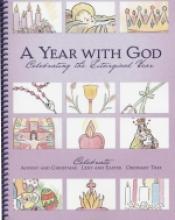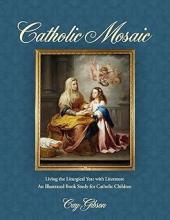The Liturgical Year General Resource
A Year With God
The Table of Contents begins with "Celebrate Advent and Christmas", continues with "Celebrate Lent and Easter", and concludes with "Celebrate Ordinary Time". This overview will provide you with an easy-to-use reference to the book, but even more valuable is the "Index of Activities" in the back of the book. This Index is arranged by the calendar year and provides page and activity references to specific Feast Days of the Church. Have you ever considered celebrating The Feast of St. Nicholas? Or the Annunciation of the Lord? Or the Feast of Our Lady of Sorrows? Now you have ready-to-go plans for these and hundreds of other special days.
Plays, craft projects, dramatic readings, games, drawings, hands-on learning, writing projects and much more employ all of the various styles of learning. Also included are the most popular longer-term projects from the CHC Lesson Plans. Many families have purchased the lesson plan sets just to have access to these enriching ideas. The wide range of projects and activities appeal to all age groups as well. I have a sixteen-year age-range between students in my own homeschool, and there are enjoyable activities for everyone, including me! The extensive artwork is professional, orthodox, and pleasing while remaining accessible and comprehensible to everyone. Produced with a variety of easily-read fonts on creamy, thick paper, the book is a joy to read while allowing both durability and excellent reproduction quality. CHC has permitted that activity pages may be copied for immediate family members, further extending the usefulness of the book. Arrangements can also be made for group copyright permissions; this is a terrific way to introduce these activities into homeschool cooperative groups, sacramental preparation classes, and other group situations.
Every other book that we have used as we have celebrated the liturgical year has been tied to the cultural traditions of different countries around the world. While we have enjoyed these experiences, there are plenty of books available to learn about them. A Year With God is different from these books; it does not include such popular and well-known traditions as the Christmas Tree or the baking of Hot Cross Buns. A Year With God is focused on the truly spiritual and universally Catholic in a way that develops and fosters growth in virtue and holiness. The richness and depth of our Faith comes alive in a way that is unforgettable, both to the student and the teacher. Take the time to really read through and use this book. It will be a blessing to your family!
Copyrights 2003/2005
Donated for review by Catholic Heritage Curricula
Catholic Mosaic – Living the Liturgical Year with Literature
The title clearly explains what this book is all about: Gibson took the twelve months of the year, wove in the liturgical celebrations and linked these to marvelous picture books – creating a mosaic of Catholic culture and beautiful literature.
But this book is much more than an annotated book list, although that is included too. Gibson gives suggested questions for you to discuss with your children. She gives suggested copywork – that is, quotes that children memorize or use for handwriting practice. She gives ideas for activities that will reinforce the meaning of the particular book. She helps families to truly live and embrace the wondrous Catholic traditions connected to feast days, liturgical celebrations and other things Catholic.
Some of the books described and linked in this book are Catholic illustrated classics – books like The Weight of a Mass by Josephine Nobisso, Song of the Swallows by Leo Politi and St. George and the Dragon by Margaret Hodges are extremely popular with many Catholic parents and children. But Gibson goes beyond the “Catholic classics” and mentions books like The Little Match Girl by Hans Christian Andersen (illustrated by Rachel Isadora) and The Giving Tree by Shel Silverstein and how you can apply Catholic teachings to these books, giving your children a rich and lasting understanding of our Catholic culture.
In total, Gibson integrates FIFTY-TWO illustrated children’s books with the Catholic calendar and Catholic living. Books that cover the Mass, First Communion, various saints and important liturgical seasons are included. In addition, she suggests other books which may also work (but omits questions and activities linked to these “second-string” books some of which unfortunately are out-of-print or hard-to-find).
All the primary books are easily attainable from booksellers; in addition, books by popular authors like Tomie dePaola are usually available at public libraries so as not to strain your book budget too much. However, after seeing these books, you might want to have good copies for your home library. Gibson has selected books not only for the meaning in their words, but also for the beauty of their illustrations. These books could easily be used as an art study in conjunction with the literature, religion and other subjects covered in these books.
Further resources that Gibson gives the reader are suggestions for creating and maintaining a “Liturgical Notebook” throughout the year – a memory scrapbook of this literature-based journey – as well as incorporating some of the traditional Catholic homeschool resources (for example, CHC’s A Year with God or Seton’s Art 1).
Run, don’t walk, to get a copy of this book. I know I sound effusive, but this book is remarkable in its ambitious objective which is stunningly successful. This is one of those homeschooling volumes that needs to be on every Catholic resource shelf – that is, when it’s not being used!
Fenestrae Fidei
I am so excited to post a review on this new coloring book! My girls and I spent a great part of the last weekend working on these beautiful pictures to color! Sean Fitzpatrick, the artist, knows very well what gets young artists to want to grab those colored pencils...
The illustrations are fairly simple for young hands and yet a more experienced artist can have a lot of fun with it. Hillside Education's site offers the suggestion of brushing the finished pictures with vegetable oil for a stained glass effect, and we did that!
Fenestrae Fidei is a companion book to Catholic Mosaic, also by Hillside Education, yet may be perfectly well used alone. For each of the illustrations, which are depicted in calendar (and liturgical) year order, there is a brief explanatory paragraph.
If you want to do it with Catholic Mosaic, a great idea would be to occupy the readers with the coloring activity while the picture book is read aloud. (Catholic Mosaic is a compendium of study/activity guides on numerous Catholic-theme picture books – many of which can be found through your local library).
Fenestrae Fidei (or, in English, "Windows of Faith") comes in a spiral bound format, with a large black & white drawing on each page. There are lots of them, as Catholic Mosaic author Cay Gibson lists four picture books per month. The drawings are all in a stylized iconic style, varying somewhat in intensity of detail. And they are just beautiful!
I would have liked to see a heavier stock paper in the pages, but what we have been doing is scanning and printing copies for home use. This allows for several children, for instance, to work on the same pictures at any time. Hillside Publications allows for coying within one family, which is of course a wonderful advantage.
Fenestrae Fidei is a very Catholic book, reflecting events of the life of Our Lord, the tradition of our Church and the holiness of the saints.
Families today are fortunate to have a product such as this!
The Year and Our Children
Originally published in the 1950s, The Year and Our Children has been the gold standard by which all other liturgical year activity books are measured. And now, Sophia Institute Press has brought this beloved gem back into print. Those of us with old dog-eared and grease stained copies, and all those who coveted those well-worn editions, thrill at the news of widespread availability of this treasure. I think I was trembling on the phone when I ordered my new copy.
This new edition is larger and easier to read than the original, and the editors at Sophia Institute Press have removed some of the more outdated information and inserted quite a few helpful footnotes. Mrs. Newland proceeds through the year, beginning at the beginning of the Church’s year in Advent and ending with All Souls and Thanksgiving. For each major feast, she describes family activities, prayers, and traditions and explains the origins of the observation of these feast days. She also explains some of the more mysterious or unknown observances, such as Rogation and ember days, and shows in each case how the family can participate in the observances in the home. I especially appreciate her treatment of All Hallows Eve, reclaiming it as a Catholic holiday.
These are more than just craft ideas or ways to decorate the home for the different holidays (though that is included); these are substantial Christian exercises to make the life of the Church real in our families. So for example, when we decorate the Christmas tree, after spending much time making significant and beautiful ornaments, there is a lovely blessing for the tree: a Psalm prayed as a group alternating lines with a reading from Ezekiel.
While the Christmas and Epiphany sections are among my favorites there are wonderful ideas in every part of the book and much to meditate upon as we move through the year of the Church. One line from the section on Lent has always stuck with me. It is so simple, simple enough for children, and yet deep enough to reflect upon all of Lent: For Him to redeem us was not an easy thing. Jesus hurt.
This book would be a thoughtful and much appreciated gift for any family who wants to enhance their participation in the year of the Church and create traditions their children will love. It would be kept for years . . . and become a well loved, dog-eared, and grease stained treasure.




